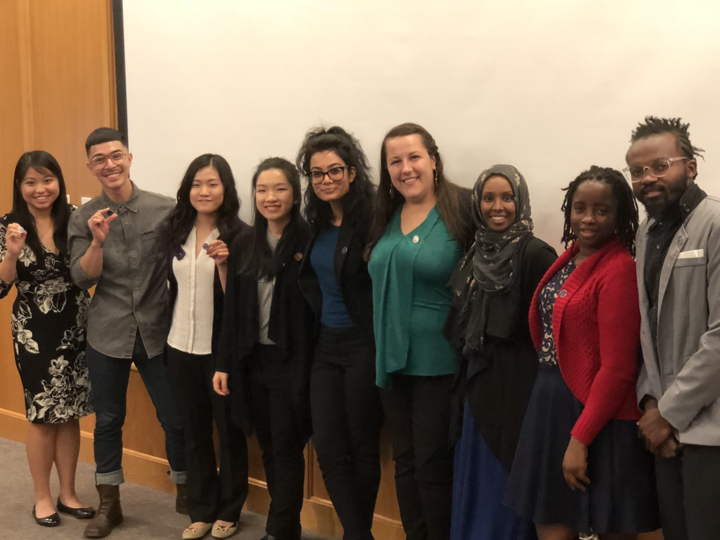Creating a More Positive Virtual Learning Experience in Higher Education: An Open Letter to Teachers and Students
Dear Teachers and Students in Higher Education,
As civility leaders, at Alfie Scholars we strive to maintain our own psychological, spiritual, and physical well-being, because this enables us to respond civilly and constructively to situations. At our recent Alfie Scholar retreat, three Alfie Team facilitators and 17 scholars focused on the challenges the scholars face as learners in this new virtual format, how to accept it, and how to develop and amplify strategies that help make it a more positive experience. Given the personal-growth dimension of our curriculum, I was worried that holding the retreats virtually would compromise the nature and depth of our work. Luckily, because we’ve developed a supportive and emotionally safe community that we consider a family, we were able to come together even in the virtual format with authenticity, trust, and gratitude that we have each other as life-lines during this extremely challenging time, a time filled with fear, uncertainty, disappointment, frustration, doubt, and loneliness. During our retreat, it was healing to feel our own individual grief, express it aloud, and witness our collective grief. All of us found solace in our feelings being shared by others, which somehow softened the blow, that in some way we were not being singled out to suffer, despite our increased solitude.
Specific to the challenges of virtual learning, we realized that most of our scholars felt the following:
Decreased motivation for class, for staying in school, and for their chosen careers, particularly considering uncertainty over job prospects with the economic projections
Overwhelmed by the length of some reading assignments
Depressed by the distressing and traumatic nature of some of the subject matter, such as poverty, violence, systemic injustice, child abuse, and genocide
Disconnected from the class and subject
Disengaged during class, especially when the class is scheduled in extra-long time-blocks
Uncomfortable having people see their private home spaces
Confined in shared living spaces with no easy place to study or engage in virtual classes without disturbing living mates
Discombobulated by not having physically separate school space for studying and separate home space for relaxing
Disorganized by irregular class schedules and logistics
Once the scholars processed their feelings, they accepted that they cannot change the reality of virtual learning or the necessity of it, but they could reframe and change their attitude about it. They do have a choice: they could take a leave of absence, so it is not a “forced” situation. By staying, they are moving closer to achieving their educational goals without interruption. So there is gratitude that they have the option to continue virtually instead of having their program cancelled. Moreover, the sacrifice of virtual learning is saving lives, and their own lives are not at risk. For this we can be grateful.
Finally, the last part of our process as civility leaders was to determine how to make a constructive contribution to improve the situation. We decided we could increase the positive experience of virtual learning by generating a list of strategies that teachers and students are undertaking that improve the experience for all involved and then sharing that list.
Following is a list of helpful strategies. I share the follow letter specific to teachers and then specific to students in part to express appreciation for those who are employing these and other strategies to help make the experience more positive, and also in hopes that others might find some of the ideas useful.
Dear Teachers,
From the discussion in our retreat, it is clear that the scholars understand that your world has been turned upside down in ways that are similar as well as different from the way their worlds have been. They can only imagine the added burdens you are managing in this moment. They also know and appreciate that you are trying your best to make this a better situation. You make virtual learning more positive when you:
1. Take care of yourself.
a. Take care of yourself as a person.
i. Tend to your mental, physical, and psycho-spiritual health.
ii. Stay connected to your colleagues and get support.
iii. Let students know how they can help you make the learning experience more positive.
Collaborate with them
iv. Ask for help if you need it.
b. Stay flexible.
c. Be forgiving of yourself and others.
d. Find something positive and inspiring each day.
2. Maintain a human touch
a. Remember that these are not normal times and that many students are isolated and need to feel they
are still connected to community, the material, and the career they have chosen.
i. Be a role model of how to manage these times.
ii. Post weekly 2-minute video chats about something of interest like a human interest story, a good
book, a movie, a show, a song, a poem.
iii. Give random compliments and other expressions of appreciation.
b. Foster inclusion and community in the virtual environment.
i. Start each class with check-ins where each student shares something brief.
1. If it is a large class, use the virtual platform break-out function. The important thing is for
students to feel connected to each other.
ii. Another option is to start class with a few minutes devoted to discussing the current situation.
iii. End class with a positive note or something inspiring.
1. Assign students or a small group of students to rotate responsibility for sharing a piece of
positive current event news.
c. Facilitate connection.
i. Help students connect to each other as whole people and learn from each other by including time
time for them to engage with each other.
ii. Create social media class groups and encourage students to post common interests and
inspirations through that.
iii. Design small break-out group activities to give students time to feel connected with each other.
1. Give clear instructions with clear time limits. Provide extra time for them to just chat a bit.
2. Keep groups small; three is ideal.
3. Change the composition of the groups so that interaction isn’t confined to one small group.
4. Make fun activities such as having them write a poem, haiku, limerick, song, or social media
post to summarize a concept
d. Hold drop-in virtual office hours.
3. Help students prepare for the virtual class session.
a. Prioritize materials, and maybe reduce the amount of content.
b. Post focus questions for long reading assignments.
c. Post free-writing, active learning, and break-out group instructions before class.
d. Record lectures in advance. If you do so, this allows you to use the virtual sessions for discussions
and break out groups.
e. Encourage students to post questions they have about the readings or the lecture before the virtual
session.
4. Create engaging virtual sessions.
a. Get help to learn the basics of operating the technology.
b. Record lectures in advance, ask the students to view them in advance at their leisure, and use virtual
sessions for discussions.
c. Use more images on PowerPoint slides.
d. Employ active learning techniques.
e. Make time for break-out groups so students can discuss and apply the concepts.
f. Provide time to process feelings about depressing subject matter.
g. Give breaks. Encourage students to get up and stretch.
5. Use resources.
a. Get student feedback.
b. Consult your campus teaching support center and IT support center.
c. Access the extensive resources available on the internet.
Dear Students,
Again, based on the discussions during our retreat, the scholars feel you. They miss seeing you in the halls, meeting rooms, food courts, libraries, walkways, outdoor sitting areas, and classrooms. They also feel the solitude of sitting alone with their thoughts and ideas, their fears and uncertainty about the plans that they so carefully made for the future, and their worry about paying bills and what their next step will be. They understand the sadness of broken dreams, and many have additional burdens to shoulder. They also know and appreciate that you are trying your best to make this a better situation. You make virtual learning more positive when you:
1. Take care of yourself.
a. Give yourself permission to feel and express your disappointment, frustration, depression, grief,
anger, sadness, and any other feelings you have about your situation. Draw them, write them, talk
about them, sing about them, dance about them. All of these feelings are valid. Accept them as real
and worthy. Breathe.
b. Find a positive frame and a lens of gratitude from which to approach your life and your learning.
c. Ask for help.
d. Maintain a schedule as if you were physically going to classes; include times to study, times to
exercise, and times to relax.
e. Create a physical signal to shift from studying time to relaxing time to help you cognitively and
emotionally maintain a routine and separation.
i. Take a shower.
ii. Change clothes.
iii. Design a ritual like lighting a candle, meditating, or playing music.
iv. Do some exercises.
v. Move the computer to the other side of the table.
f. Tend to your mental, physical, and psycho-spiritual health.
g. Find something positive and inspiring each day.
h. Stay flexible.
2. Maintain a human touch.
a. Be forgiving of yourself, your teachers, advisors, and other school personnel.
b. Build and stay connected to your community.
c. Take care of each other.
d. Have scheduled and spontaneous check-in times.
e. Form a study group, and have weekly or bi-weekly study sessions.
f. Form and have regular meet-ups with affinity groups.
g. Give random compliments and other expressions of appreciation.
3. Prepare for class.
a. Take notes about questions and ideas you have as your read or listen to the lecture.
b. Talk to a classmate about the material. It will provide an opportunity to connect with another person.
c. Dress as if you were attending in person for class sessions.
4. Engage during the class session.
a. Close all windows and software on your computer except those needed for the class during class
sessions.
b. Write down questions and ideas that you have as the discussion unfolds.
i. Write notes on a piece of paper to help with screen fatigue and help different parts of your brain
engage.
c. Stay on task in break-out assignments.
5. Use Resources.
a. Get teacher feedback.
b. Ask a peer.
c. Consult your campus student counseling, student learning support, and IT support center. The
buildings may be closed but the people are still working.
d. Access the extensive resources available on the internet.
e. Reach out to the resources that are available from your school.
These are just a few suggestions to help us all navigate these times. You can get others from your campus resources and from the internet. For example, Daniel Stanford, Director of Faculty Development and Technology at DePaul University is curating a great google spreadsheet that has a link to online resources for teacher and students from over 400 Universities. https://docs.google.com/spreadsheets/d/1VT9oiNYPyiEsGHBoDKlwLlWAsWP58sGV7A3oIuEUG3k/edit#gid=1552188977
In offering these ideas, I don’t want to add stress or create obligations for anyone. Far from it. I want to encourage both teachers and students to be gentle with themselves and each other as we navigate through these unchartered times. I only wanted to share these ideas in a simple way to provide some ease. During our Alfie Scholars retreat, brainstorming ideas and collecting strategies that are already happening helped us all feel a sense of optimism. I hope it does a bit of that for you as well.
We are in this together. We’ve got this!
With compassion and optimism,
Professor Paula Lustbader
and the Alfie Scholars Retreat Participants
Carol Cochran Hailey McNally Cesar Rios III
Scott Petit Chhavi Mehra Kaddy Suso
Jorge Arturo Lara Alvarado Mariah Moreno Christiana Tembo
Ernesto Chacon Michel Mugisha Elizabeth Vargas
Haley Cummins Adrian Nava Chloe Zabrek
Lorra Hernon Jasmina Omerovic Yue Zhang
Archival photo from Summer 2019
Archival photo from Summer 2019


